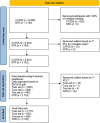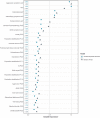A genetically informed prediction model for suicidal and aggressive behaviour in teens
- PMID: 36411277
- PMCID: PMC9678913
- DOI: 10.1038/s41398-022-02245-w
A genetically informed prediction model for suicidal and aggressive behaviour in teens
Abstract
Suicidal and aggressive behaviours cause significant personal and societal burden. As risk factors associated with these behaviours frequently overlap, combined approaches in predicting the behaviours may be useful in identifying those at risk for either. The current study aimed to create a model that predicted if individuals will exhibit suicidal behaviour, aggressive behaviour, both, or neither in late adolescence. A sample of 5,974 twins from the Child and Adolescent Twin Study in Sweden (CATSS) was broken down into a training (80%), tune (10%) and test (10%) set. The Netherlands Twin Register (NTR; N = 2702) was used for external validation. Our longitudinal data featured genetic, environmental, and psychosocial predictors derived from parental and self-report data. A stacked ensemble model was created which contained a gradient boosted machine, random forest, elastic net, and neural network. Model performance was transferable between CATSS and NTR (macro area under the receiver operating characteristic curve (AUC) [95% CI] AUCCATSS(test set) = 0.709 (0.671-0.747); AUCNTR = 0.685 (0.656-0.715), suggesting model generalisability across Northern Europe. The notable exception is suicidal behaviours in the NTR, which was no better than chance. The 25 highest scoring variable importance scores for the gradient boosted machines and random forest models included self-reported psychiatric symptoms in mid-adolescence, sex, and polygenic scores for psychiatric traits. The model's performance is comparable to current prediction models that use clinical interviews and is not yet suitable for clinical use. Moreover, genetic variables may have a role to play in predictive models of adolescent psychopathology.
© 2022. The Author(s).
Conflict of interest statement
HL reports receiving grants from Shire Pharmaceuticals; personal fees from and serving as a speaker for Medice, Shire/Takeda Pharmaceuticals and Evolan Pharma AB; and sponsorship for a conference on attention-deficit/hyperactivity disorder from Shire/Takeda Pharmaceuticals and Evolan Pharma AB, all outside the submitted work. All other authors report no conflicts of interest.
Figures



Similar articles
-
Association of Genome-Wide Polygenic Scores for Multiple Psychiatric and Common Traits in Preadolescent Youths at Risk of Suicide.JAMA Netw Open. 2022 Feb 1;5(2):e2148585. doi: 10.1001/jamanetworkopen.2021.48585. JAMA Netw Open. 2022. PMID: 35188556 Free PMC article.
-
Predicting suicide attempt or suicide death following a visit to psychiatric specialty care: A machine learning study using Swedish national registry data.PLoS Med. 2020 Nov 6;17(11):e1003416. doi: 10.1371/journal.pmed.1003416. eCollection 2020 Nov. PLoS Med. 2020. PMID: 33156863 Free PMC article.
-
Prediction of Suicidal Behaviors in the Middle-aged Population: Machine Learning Analyses of UK Biobank.JMIR Public Health Surveill. 2023 Feb 20;9:e43419. doi: 10.2196/43419. JMIR Public Health Surveill. 2023. PMID: 36805366 Free PMC article.
-
Prevalence of suicidal ideation and self-harm behaviours in children aged 12 years and younger: a systematic review and meta-analysis.Lancet Psychiatry. 2022 Sep;9(9):703-714. doi: 10.1016/S2215-0366(22)00193-6. Epub 2022 Jul 27. Lancet Psychiatry. 2022. PMID: 35907406
-
Is suicidal behaviour a stronger predictor of later suicide than suicidal ideation? A systematic review and meta-analysis.Aust N Z J Psychiatry. 2021 Mar;55(3):254-267. doi: 10.1177/0004867420931161. Epub 2020 Jun 24. Aust N Z J Psychiatry. 2021. PMID: 32579030
Cited by
-
Building machine learning prediction models for well-being using predictors from the exposome and genome in a population cohort.Nat Ment Health. 2024;2(10):1217-1230. doi: 10.1038/s44220-024-00294-2. Epub 2024 Aug 14. Nat Ment Health. 2024. PMID: 39464304 Free PMC article.
-
Evidence for the biopsychosocial model of suicide: a review of whole person modeling studies using machine learning.Front Psychiatry. 2024 Jan 11;14:1294666. doi: 10.3389/fpsyt.2023.1294666. eCollection 2023. Front Psychiatry. 2024. PMID: 38274429 Free PMC article.
References
-
- Brownstein HH The social reality of violence and violent crime: Allyn and Bacon Boston; 2000.
Publication types
MeSH terms
LinkOut - more resources
Full Text Sources
Medical
Research Materials

